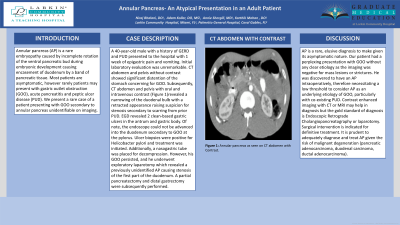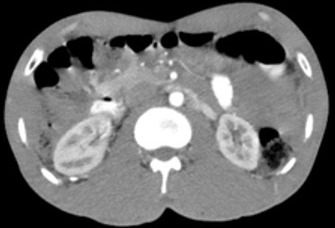Tuesday Poster Session
Category: Biliary/Pancreas
P2932 - Annular Pancreas: An Atypical Presentation in an Adult Patient
Tuesday, October 24, 2023
10:30 AM - 4:00 PM PT
Location: Exhibit Hall

Has Audio

Adam Z. Koller, DO, MS
Palmetto General Hospital
Coral Gables, FL
Presenting Author(s)
Niraj Bhalani, DO1, Adam Z. Koller, DO, MS2, Annie Shergill, MD1, Karthik Mohan, DO1
1Larkin Community Hospital, Miami, FL; 2Palmetto General Hospital, Coral Gables, FL
Introduction: Annular pancreas (AP) is a rare embryopathy caused by incomplete rotation of the ventral pancreatic bud during embryonic development causing encasement of duodenum by a band of pancreatic tissue. Most patients are asymptomatic, however rarely patients may present with gastric outlet obstruction (GOO), acute pancreatitis and peptic ulcer disease (PUD). We present a rare case of a patient presenting with GOO secondary to annular pancreas unidentifiable on imaging.
Case Description/Methods: A 40-year-old male with a history of GERD and PUD presented to the hospital with 1 week of epigastric pain and vomiting. Initial laboratory evaluation was unremarkable. CT abdomen and pelvis without contrast showed significant distention of the stomach concerning for GOO. Subsequently, CT abdomen and pelvis with oral and intravenous contrast revealed a narrowing of the duodenal bulb with a retracted appearance raising suspicion for stenosis secondary to scarring from prior PUD. EGD revealed 2 clean-based gastric ulcers in the antrum and gastric body. Of note, the endoscope could not be advanced into the duodenum secondary to GOO at the pylorus. Ulcer biopsies were positive for Helicobacter pylori and treatment was initiated. Additionally, a nasogastric tube was placed for decompression. However, his GOO persisted, and he underwent exploratory laparotomy which revealed a previously unidentified AP causing stenosis of the first part of the duodenum. A partial pancreatectomy and distal gastrectomy were subsequently performed.
Discussion: AP is a rare, elusive diagnosis to make given its asymptomatic nature. Our patient had a perplexing presentation with GOO without any clear etiology as the imaging was negative for mass lesions or strictures. He was discovered to have an AP intraoperatively, therefore necessitating a low threshold to consider AP as an underlying etiology of GOO, particularly with co-existing PUD. Contrast enhanced imaging with CT or MRI may help in diagnosis but the gold standard of diagnosis is Endoscopic Retrograde Cholangiopancreatography or laparotomy. Surgical intervention is indicated for definitive treatment. It is prudent to adequately diagnose and treat AP given the risk of malignant degeneration (pancreatic adenocarcinoma, duodenal carcinoma, ductal adenocarcinoma).

Disclosures:
Niraj Bhalani, DO1, Adam Z. Koller, DO, MS2, Annie Shergill, MD1, Karthik Mohan, DO1. P2932 - Annular Pancreas: An Atypical Presentation in an Adult Patient, ACG 2023 Annual Scientific Meeting Abstracts. Vancouver, BC, Canada: American College of Gastroenterology.
1Larkin Community Hospital, Miami, FL; 2Palmetto General Hospital, Coral Gables, FL
Introduction: Annular pancreas (AP) is a rare embryopathy caused by incomplete rotation of the ventral pancreatic bud during embryonic development causing encasement of duodenum by a band of pancreatic tissue. Most patients are asymptomatic, however rarely patients may present with gastric outlet obstruction (GOO), acute pancreatitis and peptic ulcer disease (PUD). We present a rare case of a patient presenting with GOO secondary to annular pancreas unidentifiable on imaging.
Case Description/Methods: A 40-year-old male with a history of GERD and PUD presented to the hospital with 1 week of epigastric pain and vomiting. Initial laboratory evaluation was unremarkable. CT abdomen and pelvis without contrast showed significant distention of the stomach concerning for GOO. Subsequently, CT abdomen and pelvis with oral and intravenous contrast revealed a narrowing of the duodenal bulb with a retracted appearance raising suspicion for stenosis secondary to scarring from prior PUD. EGD revealed 2 clean-based gastric ulcers in the antrum and gastric body. Of note, the endoscope could not be advanced into the duodenum secondary to GOO at the pylorus. Ulcer biopsies were positive for Helicobacter pylori and treatment was initiated. Additionally, a nasogastric tube was placed for decompression. However, his GOO persisted, and he underwent exploratory laparotomy which revealed a previously unidentified AP causing stenosis of the first part of the duodenum. A partial pancreatectomy and distal gastrectomy were subsequently performed.
Discussion: AP is a rare, elusive diagnosis to make given its asymptomatic nature. Our patient had a perplexing presentation with GOO without any clear etiology as the imaging was negative for mass lesions or strictures. He was discovered to have an AP intraoperatively, therefore necessitating a low threshold to consider AP as an underlying etiology of GOO, particularly with co-existing PUD. Contrast enhanced imaging with CT or MRI may help in diagnosis but the gold standard of diagnosis is Endoscopic Retrograde Cholangiopancreatography or laparotomy. Surgical intervention is indicated for definitive treatment. It is prudent to adequately diagnose and treat AP given the risk of malignant degeneration (pancreatic adenocarcinoma, duodenal carcinoma, ductal adenocarcinoma).

Figure: Annular pancreas (CT with contrast)
Disclosures:
Niraj Bhalani indicated no relevant financial relationships.
Adam Koller indicated no relevant financial relationships.
Annie Shergill indicated no relevant financial relationships.
Karthik Mohan indicated no relevant financial relationships.
Niraj Bhalani, DO1, Adam Z. Koller, DO, MS2, Annie Shergill, MD1, Karthik Mohan, DO1. P2932 - Annular Pancreas: An Atypical Presentation in an Adult Patient, ACG 2023 Annual Scientific Meeting Abstracts. Vancouver, BC, Canada: American College of Gastroenterology.
